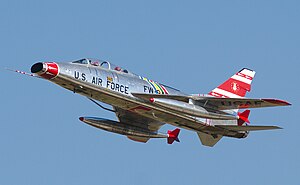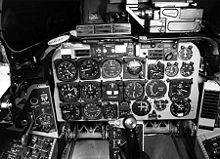 |
|
| General information | |
|---|---|
| Type | |
| Manufacturer | North American Aviation |
| Status | Retired; one example airworthy as a warbird. |
| Primary users | United States Air ForceTurkish Air Force Republic of China Air Force French Air Force |
| Number built | 2,294 |
| History | |
| Manufactured | 1953–1959 |
| Introduction date | 27 September 1954 |
| First flight | 25 May 1953 |
| Retired | 1979, United States Air National Guard; 1988, Republic of China Air Force |
| Developed from | North American F-86 Sabre |
| Developed into | North American F-107 |

The North American F-100 Super Sabre is a supersonic fighter aircraft. It was one of the first aircraft with a stabilator, or all-moving tailplane. Unlike modern stabilators which use an anti-servo tab, gearing and a variable stiffness spring were attached to the control stick to provide acceptable resistance to prevent pilot-induced oscillation. Unusually, the aircraft made extensive use of titanium throughout key areas of the airframe.
Take off Distance
MAX RANGE
Aircraft Speed
Max Crew


On 27 September 1954, the F-100A officially entered USAF service with the 479th Fighter Wing, based at George AFB, California. By 10 November 1954, the F-100As suffered six major accidents
The North American F-100 Super Sabre is an American supersonic jet fighter aircraft designed and produced by North American Aviation.
the F-100F Super Sabre (tail number 56-3844) returning to the sky! She last flew in 2018. This flight was mainly a functional check flight.